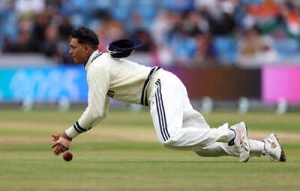Table tennis in India is poised for significant development following the launch of WTT Event Management Pvt. Ltd. by World Table Tennis (WTT), the commercial arm of the International Table Tennis Federation (ITTF). This initiative, coming shortly after the sixth edition of Ultimate Table Tennis (UTT), aims to boost WTT tournaments and nurture the table tennis ecosystem within the country.
The immediate goal is to expand the presence of WTT events in India, initially focusing on smaller-scale tournaments. Currently, India hosts a WTT Star Contender, a fourth-tier event. The long-term vision involves gradually escalating to major international events. A key component of the strategy is to broaden the base of players through more feeder tournaments targeting younger talent.
WTT CEO Steve Dainton emphasized a long-term commitment to India, envisioning a 10-year plan leading up to the 2036 Olympics, for which India has expressed interest in hosting.
"We start with grassroots events, which allows more Indian players to play and gives them the exposure that they need in the beginning. But ambition is there and of course, if 2036 Olympics come into India, then it's important for us to also have major events and get more fans behind the bigger table tennis events as well."
WTT has implemented similar programs in other nations, including China, Singapore, and recently the USA. Unlike their top-down approach in the USA, they will adopt a grassroots-focused strategy in India.
This strategic move underscores the world body's recognition of India as a valuable market, demonstrated by a committed investment of $3-5 million (Rs 26-43 Cr.) over the coming years.
This new initiative has garnered support from key figures in Indian table tennis, including retired legend Sharath Kamal, who serves as an ambassador, and Vita Dani, Chairperson of UTT and a governing board member of the ITTF Foundation.
Sharath Kamal highlighted the opportunities that WTT Feeder tournaments will create for emerging players. "Having [WTT] Feeder tournaments in India gives a lot of chances to the up-and-coming players, those aged between 17 and 23-24 who can slowly start to make a mark in the international level."
He further elaborated on the challenges faced by young players: "Many young players don't have the possibility to go abroad due to financial constraints or national entry restrictions...Here Indian players will have a lot of opportunities to make world ranking points and slowly get into the system where from the Feeder tournaments they will qualify to play the Contenders."
The development of young talent is paramount, and Dani Sports Foundation is already involved in scouting for future stars.
Sharath also emphasized the psychological benefits of playing at home: "These tournaments at home give confidence to a young player...That is something which I personally have [experienced]." He cited examples of his own successes on home soil, highlighting the confidence boost derived from playing in familiar environments.
WTT's interest in India has been brewing for years, with initial discussions dating back to 2017.
Dainton stated that, "[India is] the most populous country in the world, it's important for us to put a fair bit of attention on that," adding, "Our ambition is to be the second most popular sport in India." He also highlighted the accessibility of table tennis, making it a suitable sport for a densely populated nation.
He drew parallels between the Indian market and the USA, noting the existing interest in the sport but the absence of widespread popularization.
A significant challenge lies in engaging the Table Tennis Federation of India (TTFI), which has faced internal turmoil in recent years. The national federation's cooperation is crucial for aligning domestic events and ensuring a cohesive pathway for players. ESPN has reached out to TTFI for comment.
Another hurdle is increasing fan engagement beyond major multi-sport events. While UTT has witnessed growing popularity, sustained viewership for regular WTT tour events remains a challenge.
Vita Dani remains optimistic, citing the growing attendance at UTT events as evidence of the sport's potential in India. UTT has also been proactively experimenting with innovative formats and camera angles to enhance the viewing experience.
WTT, known for introducing innovations like the review system and the mixed team format, will need to continue its efforts to capture audience attention in the competitive Indian sports market.
If successful, this initiative has the potential to transform table tennis from a popular recreational activity into a breeding ground for international champions.
Newer articles
Older articles
 Chess Star Praggnanandhaa Weighs In on Carlsen's Frustration After Loss to Gukesh
Chess Star Praggnanandhaa Weighs In on Carlsen's Frustration After Loss to Gukesh
 Samsung Galaxy A35 5G and A55 5G: Official Pricing and Availability Announced
Samsung Galaxy A35 5G and A55 5G: Official Pricing and Availability Announced
 India's Fielding Woes Blamed for First Test Defeat Against England: Former Selector Voices Concerns
India's Fielding Woes Blamed for First Test Defeat Against England: Former Selector Voices Concerns
 Headline: Viral Optical Illusion: Can You Find All the Hidden Animals? Only 1% Succeed
Headline: Viral Optical Illusion: Can You Find All the Hidden Animals? Only 1% Succeed
 Shadman Stands By Bangladesh Batters After Day 1 Struggles Against Sri Lanka
Shadman Stands By Bangladesh Batters After Day 1 Struggles Against Sri Lanka
 Norris Claims Thrilling Austrian GP Victory After Intense Duel with McLaren Teammate Piastri
Norris Claims Thrilling Austrian GP Victory After Intense Duel with McLaren Teammate Piastri
 Jake Paul's Title Dreams: Analyzing Championship Prospects and Potential Opponents
Jake Paul's Title Dreams: Analyzing Championship Prospects and Potential Opponents
 Gavaskar Urges India to Unleash Kuldeep Yadav in Second Test Amid Bumrah Fitness Concerns
Gavaskar Urges India to Unleash Kuldeep Yadav in Second Test Amid Bumrah Fitness Concerns
 iQoo Z9 Turbo Leaks: Snapdragon 8s Gen 3, 1.5K Display, and Massive Battery Detailed
iQoo Z9 Turbo Leaks: Snapdragon 8s Gen 3, 1.5K Display, and Massive Battery Detailed
 Mirabai Chanu Reveals Relentless Dedication: Training and Weight Always Top of Mind, Even During Family Time
Mirabai Chanu Reveals Relentless Dedication: Training and Weight Always Top of Mind, Even During Family Time